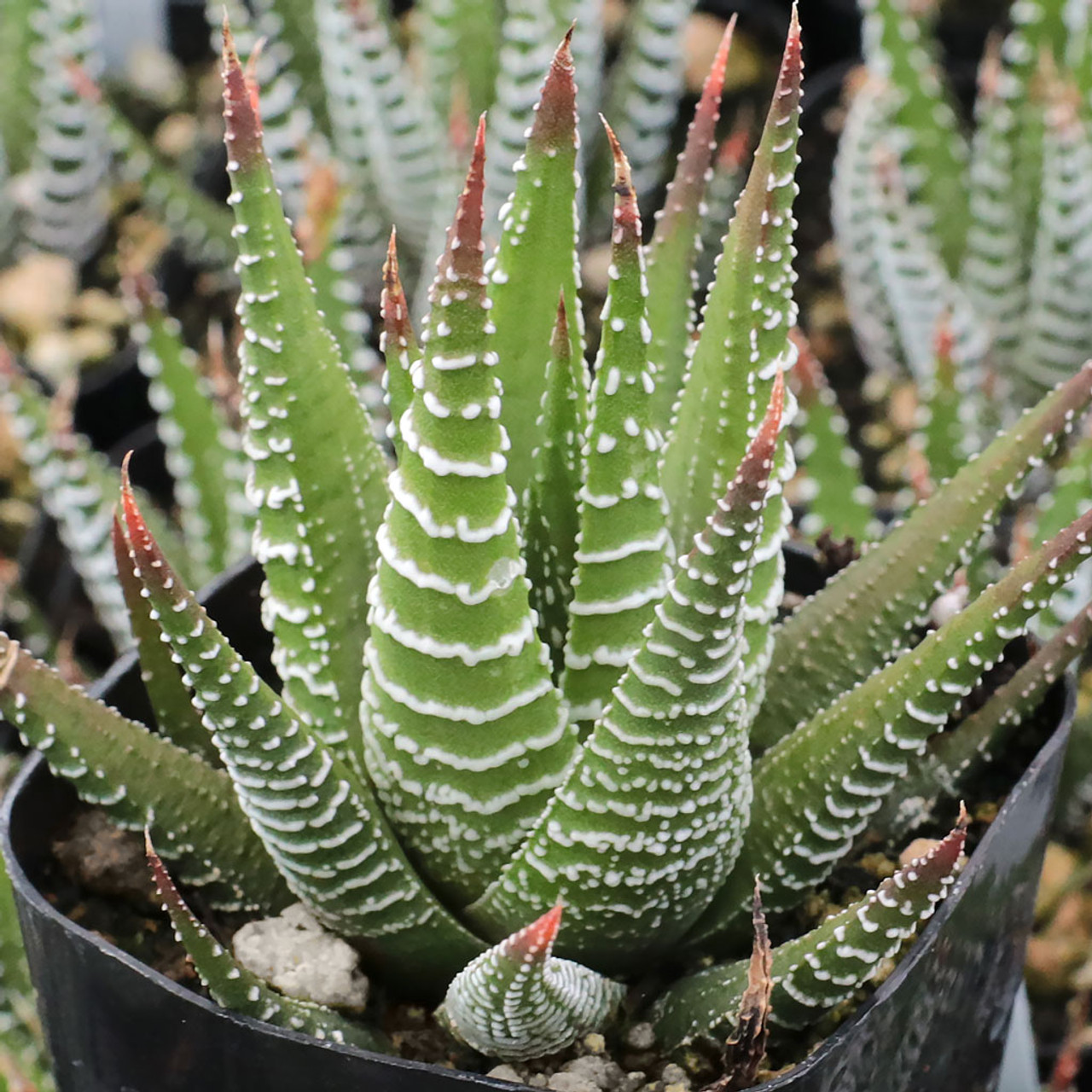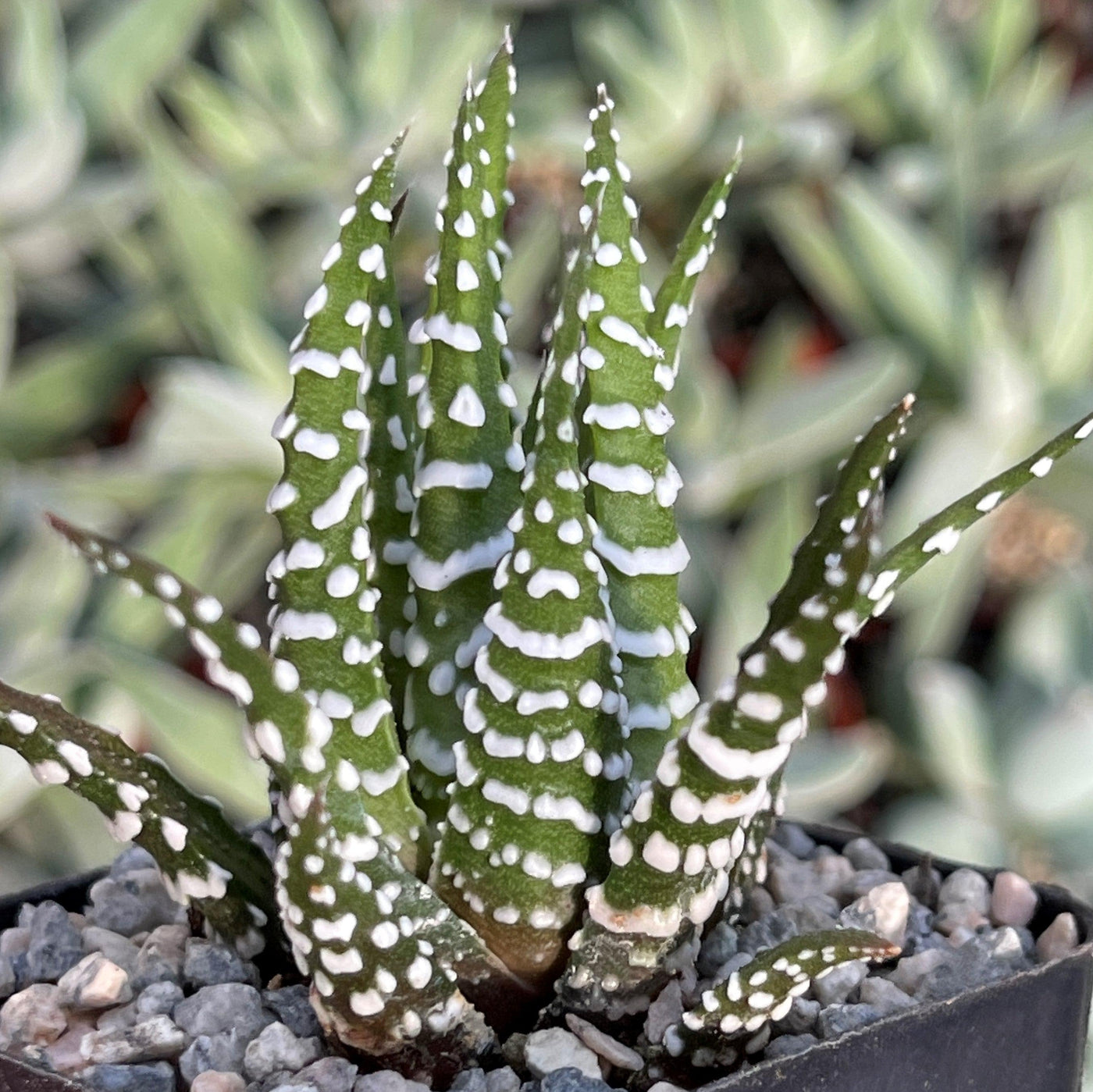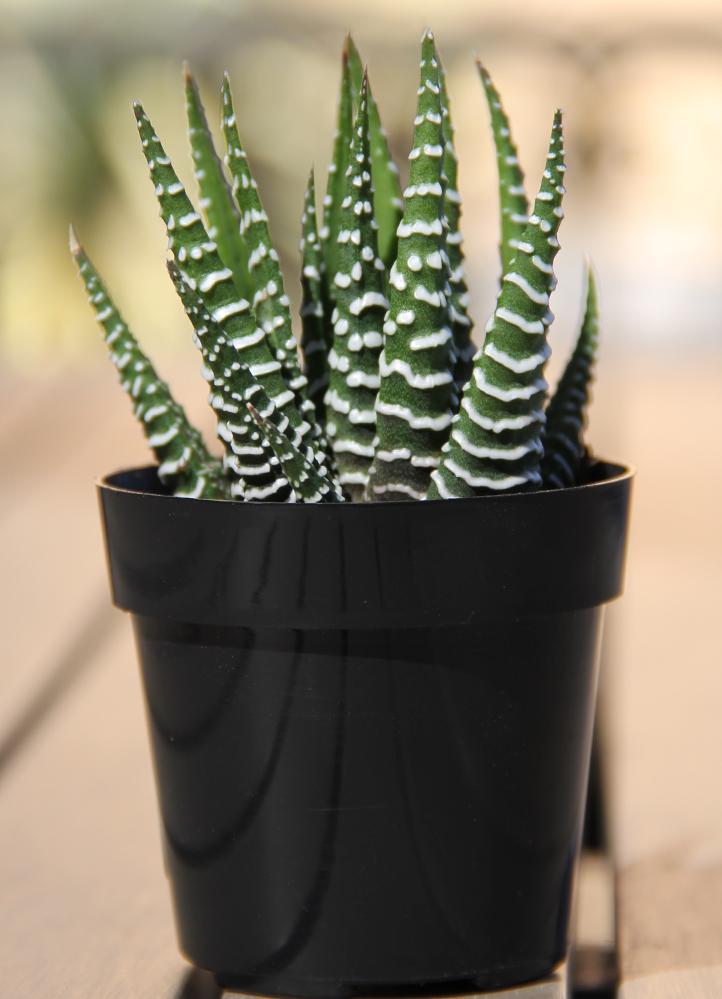This succulent is a perfect addition to your indoor succulent garden. Its leaves are thick and dark green, and have distinctive white, horizontal stripes on the exterior. The interior of the leaves is smooth to the touch.
Table of Contents
Care and Propagation Information
Haworthiopsis fasciata “Zebra Plant” is an ideal succulent for novice gardeners, as it thrives indoors when given the right attention. Its ability to propagate easily makes it a great choice for decorating or gifting.
Watering
Haworthiopsis fasciata “Zebra Plant” requires the typical amount of water for a succulent. It is best to use the “soak and dry” technique, allowing the soil to dry out fully between watering sessions.
Be sure to download our FREE watering cheat sheet so you can discover how to tell if your succulents are over-watered and how to revive them if necessary.
Where to Plant
Haworthiopsis fasciata is not tolerant to temperatures lower than 30° F (-1.1° C), so it is advisable to keep this succulent in a container that can be brought indoors if you live in an area with cold winter temperatures.
Suggestion: Place the plant in a spot of your garden that receives direct sunlight for four to six hours each day, preferably in the morning.
If exposed to more intense sunlight, the plant will develop a dark red hue, indicating it is under duress. An excessive amount of sunlight will cause the plant to turn white and become desiccated.
Put the plant in a sunny window if you are growing it indoors.
Flowering Information
Haworthiopsis fasciata produces small white or pink blooms on a tall, thin stem when grown outdoors in the autumn season.
How to Propagate Haworthiopsis fasciata
Haworthiopsis fasciata “Zebra Plant” can be quickly multiplied with the use of offshoots.
Offsets
The Zebra Plant will grow small offshoots around its base which can be pulled up and left to dry for one to two days before being replanted in soil that drains well.
Commonly Mistaken For
Haworthiopsis attenuata can be easily identified by its slender leaves. Though the differences between it and other Haworthiopsis species may be subtle, its thin leaves make it stand out.
The leaves of Haworthiopsis fasciata “Zebra Plant” are smoother than those of Haworthiopsis attenuate, and are also thicker in size.
The Zebra Plant is often mistaken for Aloe, as both types of plants have various shades of green, from dark to bright, and have thick, pointed leaves.
Previously Known As
Care and Propagation Information
General Care for Haworthiopsis fasciata
Haworthiopsis fasciata “Zebra Plant” is an ideal succulent for novice gardeners, as it thrives indoors when given the right attention. Its ability to propagate easily makes it a great choice for decorating or gifting.
Watering
Haworthiopsis fasciata “Zebra Plant” requires the typical amount of water for a succulent. It is best to use the “soak and dry” technique, allowing the soil to dry out fully between watering sessions.
Be sure to download our FREE watering cheat sheet so you can discover how to tell if your succulents are over-watered and how to revive them if necessary.
Where to Plant
Haworthiopsis fasciata is not tolerant to temperatures lower than 30° F (-1.1° C), so it is advisable to keep this succulent in a container that can be brought indoors if you live in an area with cold winter temperatures.
Suggestion: Place the plant in a spot of your garden that receives direct sunlight for four to six hours each day, preferably in the morning.
If exposed to more intense sunlight, the plant will develop a dark red hue, indicating it is under duress. An excessive amount of sunlight will cause the plant to turn white and become desiccated.
Put the plant in a sunny window if you are growing it indoors.
Flowering Information
Haworthiopsis fasciata produces small white or pink blooms on a tall, thin stem when grown outdoors in the autumn season.
How to Propagate Haworthiopsis fasciata
Haworthiopsis fasciata “Zebra Plant” can be quickly multiplied with the use of offshoots.
Offsets
The Zebra Plant will grow small offshoots around its base which can be pulled up and left to dry for one to two days before being replanted in soil that drains well.
Commonly Mistaken For
Haworthiopsis attenuata can be easily identified by its slender leaves. Though the differences between it and other Haworthiopsis species may be subtle, its thin leaves make it stand out.
The leaves of Haworthiopsis fasciata “Zebra Plant” are smoother than those of Haworthiopsis attenuate, and are also thicker in size.
The Zebra Plant is often mistaken for Aloe, as both types of plants have various shades of green, from dark to bright, and have thick, pointed leaves.
Previously Known As
is a small succulent.
The Zebra Plant, a succulent species of Haworthia fasciata, is a small-sized plant.
FAQ
How do you make zebra haworthia grow faster?
Reduce the amount of water given to the plant and let it dry out in order to recover from overwatering. Avoid watering until the soil has dried out completely. If the soil is not drying quickly, choose a soil mixture that drains faster.
Is Haworthia good for indoors?
Haworthias can survive in dry, warm climates with indirect sunlight or partial shade from trees and rocks. When kept as houseplants, they should be in temperatures of 75-90°F. Though they can tolerate lower lighting, they will develop better color and bloom more if they receive bright, indirect light.
Is Haworthia fasciata an indoor plant?
Haworthia can be grown indoors as houseplants, although they need ample light but not full sun all day. These plants prefer temperatures between 70 and 95 degrees Fahrenheit and soil that is sandy and well-draining, yet still retains some moisture, especially during the summer months. The soil should also be neutral.
How long does Zebra Haworthia live?
Within the next half-century
Is zebra succulent rare?
Its leaves are arranged in rosettes that are 6-12 cm in diameter with tapered ends and stripes of white tubercles. It is an evergreen plant that can easily spread and form clumps in its natural environment.



